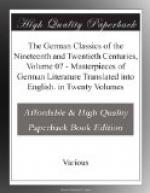exemplify the universal flow of life? Hegel finds
that indeed to be the case. Concepts we daily
use, such as quality and quantity, essence and phenomenon,
appearance and reality, matter and force, cause and
effect, are not fixed and isolated entities, but form
a continuous system of interdependent elements.
Stated dogmatically the meaning is this: As concavity
and convexity are inseparably connected, though one
is the very opposite of the other—as one
cannot, so to speak, live without the other, both
being always found in union—so can no concept
be discovered that is not thus wedded to its contradiction.
Every concept develops, upon analysis, a stubbornly
negative mate. No concept is statable or definable
without its opposite; one involves the other.
One cannot speak of motion without implying rest;
one cannot mention the finite without at the same
time referring to the infinite; one cannot define
cause without explicitly defining effect. Not
only is this true, but concepts, when applied, reveal
perpetual oscillation. Take the terms “north”
and “south.” The mention of the north
pole, for example, implies at once the south pole
also; it can be distinguished only by contrast with
the other, which it thus includes. But
it is a north pole only by excluding the south
pole from itself—by being itself and not
merely what the other is not. The situation is
paradoxical enough: Each aspect—the
negative or the positive—of anything appears
to exclude the other, while each requires its own other
for its very definition and expression. It needs
the other, and yet is independent of it. How
Hegel proves this of all concepts, cannot here be shown.
The result is that no concept can be taken by itself
as a “that-and-no-other.” It is perpetually
accompanied by its “other” as man is by
his shadow. The attempt to isolate any logical
category and regard it as fixed and stable thus proves
futile. Each category—to show this
is the task of Hegel’s Logic—is
itself an organism, the result of a process which
takes place within its inner constitution. And
all logical categories, inevitably used in describing
and explaining our world, form one system of interdependent
and organically related parts. Hegel begins with
an analysis of a concept that most abstractly describes
reality, follows it through its countless conflicts
and contradictions, and finally reaches the highest
category which, including all the foregoing categories
in organic unity, is alone adequate to characterize
the universe as an organism. What these categories
are and what Hegel’s procedure is in showing
their necessary sequential development, can here not
even be hinted at.




